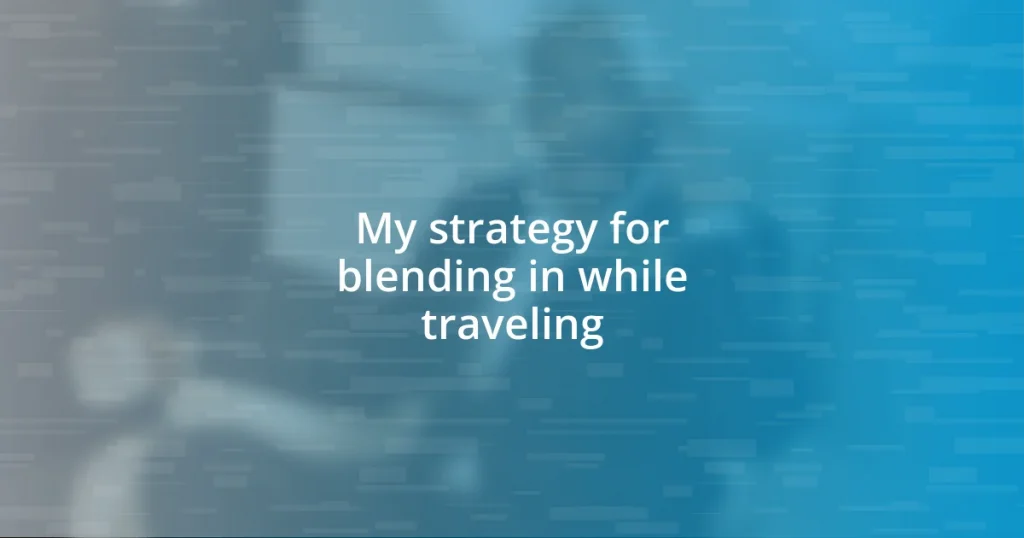Key takeaways:
- Immersing in local culture through food, greetings, and community events enhances connections and understanding of traditions.
- Researching dress codes and adapting to local customs shows respect and can significantly improve travel experiences.
- Engaging with locals respectfully, through active listening and understanding body language, fosters authentic interactions and deeper connections.

Understanding local culture
When traveling, I always make an effort to immerse myself in the local culture. I remember walking through a small village in Italy and being invited to join a family meal. Their warmth and openness transformed a simple dinner into a heartwarming experience that connected me deeply to their traditions. Isn’t it fascinating how food can be a universal language that binds us together?
I’ve found that observing social customs—like greetings, gestures, or even dining etiquette—can uncover layers of meaning that are not immediately apparent. Once, during my travels in Japan, I was struck by the importance of bowing as a greeting. The nuanced way to bow depending on the situation revealed so much about respect in their culture. How often do we overlook these subtle details when we travel?
Engaging with locals, whether by chatting with a vendor at a market or joining a community event, enhances my understanding of their way of life. I recall attending a traditional dance festival in Peru, where I felt the pride of the community flowing through every move. It made me wonder: how can we ever fully appreciate a place if we don’t dive beneath the surface?

Researching dress codes
When I travel, researching dress codes becomes a crucial part of my preparation. I recall my trip to Morocco, where wearing loose, modest clothing not only helped me blend in but also shielded me from the sun’s heat. The respect for local norms often opens doors that simply looking like a tourist would keep shut. Have you ever felt out of place simply because of how you were dressed?
What excites me about understanding dress codes is that they can be a reflection of culture and history. For instance, in Italy, I found that wearing more formal attire in cities like Florence is a sign of respecting the rich art and architecture surrounding you. This isn’t just about aesthetics; it’s a way of showing appreciation for the place you are visiting. I often think about how a simple change in wardrobe can transform the entire experience of a trip.
I’ve learned that the specifics can vary widely—from religious sites to dining experiences. In Thailand, I was taken aback by the requirement to cover shoulders and knees when entering temples. It became a lesson for me on the significance of their traditions. Who knew that something as simple as clothing could convey such deep respect?
| Location | Dress Code |
|---|---|
| Morocco | Loose, modest clothing |
| Italy | Smart casual or formal, especially in cities |
| Thailand | Shoulders and knees covered in temples |

Learning basic local phrases
Learning a few basic local phrases can dramatically enhance one’s travel experience. I remember my first trip to Brazil, where my attempts to say “Oi!” (hello) and “Obrigado” (thank you) were met with enthusiastic smiles. It’s remarkable how a few words can create a bridge between you and the locals, making interactions feel more genuine. I’ve noticed that even simple phrases can evoke a sense of respect and eagerness to connect.
Here are some essential phrases that can make a difference wherever you go:
- Hello/Hi: A friendly greeting sets the tone.
- Thank you: A simple way to show appreciation.
- Please: It softens requests and shows politeness.
- Sorry: Essential for handling any unintentional mistakes.
- Help: Useful in any situation, especially if you’re lost.
- Where is…?: A practical phrase for navigating a new place.
By learning these basics, not only do you show respect for the local culture, but you also invite warmth and openness in your interactions. Just think about how surprising it is when someone mentions your language—small efforts truly go a long way!

Adapting to local customs
When it comes to adapting to local customs, I’ve found that observing social etiquette is just as important as understanding dress codes. During my travels in Japan, I was initially baffled by the customs of bowing and removing shoes before entering homes. However, once I embraced these practices, the locals began to treat me as one of their own. Isn’t it fascinating how small gestures can lead to deeper connections with people?
Food customs offer another layer of cultural integration. I distinctly remember dining in a family-owned restaurant in Spain where I hesitated to begin eating before the host. When I finally learned that it’s customary to wait for everyone to be served and for the eldest to start, I gained immeasurable respect from the family. It struck me how sharing a meal is not just about food—it’s about the bonds we create at the table. Have you ever felt the warmth of acceptance just by knowing the right way to behave?
Furthermore, understanding local gestures can help avoid cultural faux pas. In India, I learned that the ‘thumbs up’ gesture, commonly positive in many Western cultures, can have a slightly different meaning there. I remember a moment of embarrassment when I unknowingly used it at a local market and saw the seller’s confused expression. Isn’t it amazing how a tiny misunderstanding can turn into a learning opportunity? Adapting to such nuances can transform your travel experience from ordinary to extraordinary.

Observing social behaviors
Observing social behaviors is a crucial part of blending in while traveling. I remember standing in a bustling market in Marrakech, captivated by how people interacted. Locals greeted each other with hearty exchanges, animated gestures, and laughter. As I quietly took it all in, I couldn’t help but feel that absorbing such vibrant social dynamics was a language of its own. Have you ever noticed how energy shifts when you pay attention to the way people connect?
In my experience, body language speaks volumes in social settings. For instance, while waiting for a train in Italy, I saw how locals leaned into conversations, using meaningful eye contact and an open stance to engage one another. Adopting a similar posture made me feel more included and approachable. It’s a subtle reminder that sometimes, it’s not just what you say, but how you present yourself that defines your interactions. Have you ever felt the difference in how people respond when you mirror their behavior?
Another memorable lesson for me came during a festival in Rio de Janeiro. I noticed how interactions shifted in various groups—some danced with abandon, while others engaged in animated discussions. It struck me that understanding the rhythm of social interactions is key. I found myself stepping into the dance circle, and in that moment, the joy and acceptance felt infectious. Isn’t it incredible how simply participating can unravel layers of cultural intricacies? Observing these behaviors not only helped me fit in but also enriched my travel experience beyond measure.

Choosing appropriate body language
Choosing the right body language can significantly impact how you blend into a new culture. I recall wandering through the serene rice paddies in Bali, where everyone seemed to move with a calm grace. By adopting a softer posture, like relaxing my shoulders and minimizing abrupt movements, I noticed both the locals and my fellow travelers responded positively. How can a simple shift in body posture convey openness and warmth?
It’s also worth considering how you position yourself in relation to others. In my travels, I found that mirroring the spatial distance favored by locals helps to build trust. For example, while visiting a café in Paris, I instinctively leaned in closer during conversations, matching the French norm of intimacy. This subtle alignment helped me feel more connected to the vibrant discussions around me. Have you ever thought about how proximity can influence your comfort and acceptance in a new social setting?
Emphasizing facial expressions holds equal importance. During a lively festival in Thailand, I made a conscious effort to smile genuinely, as I realized it’s a universal gesture of friendliness. As I exchanged smiles with the locals, their faces lit up, and I felt an unmistakable bond forming in those fleeting moments. Have you noticed how a simple smile can bridge cultural divides and create a sense of belonging? Engaging with others through thoughtful body language not only enhances your experience but also deepens your appreciation for the rich tapestry of human connections.

Engaging with locals respectfully
Building connections with locals requires a genuine approach and a sense of respect. I’ll never forget one chilly evening in Edinburgh when I struck up a conversation with an elderly gentleman at a pub. Instead of rushing into questions, I started by asking his thoughts on a local dish I had just tried. His eyes sparkled as he shared a slice of his life, which opened the door to a deeper dialogue about his family’s history. Have you ever felt that warm rush of camaraderie when someone sees you as more than just a visitor?
It’s essential to adapt to local customs and practices when engaging with others. During a trip to Japan, I realized the importance of bowing and pausing before speaking. I remember feeling a little awkward at first, but once I made the effort to bow slightly when greeting, the locals smiled back warmly. In these instances, I found that respecting cultural norms is not just about fitting in; it’s about honoring the values intrinsic to that culture. Have you considered how embracing such small gestures can forge stronger bonds?
Active listening can enhance interactions, as it shows you value what others have to say. I vividly recall chatting with a street artist in Mexico City. Instead of interjecting with my own stories, I genuinely listened to his passion about capturing the city’s spirit on canvas. His excitement was infectious, and I felt as if I became a part of his world for those moments. Have you thought about how your presence can transform a conversation simply by being attentive? Engaging with locals respectfully isn’t just a strategy; it’s a way to create authentic experiences that enrich your travels.














